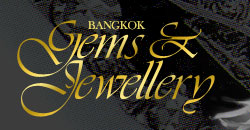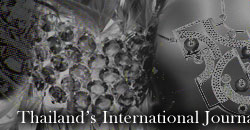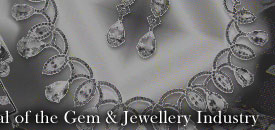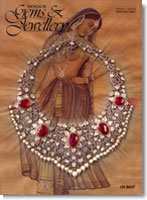| Alexandrite
An Emerald by Day, An Amethyst by Night |
. The year
was 1830, when Ekaterinburg (named for the Russian Empress Catherine
II) was a bustling city on the route from Russia to Siberia. The date
was April 23, the date of the young Czarevitch Alexander Nicolajevitch's
birthday, when as legend goes, a new gem was discovered and created
a sensation. A variety of chrysoberyl was found that was bright green
in daylight and rich red when seen under artificial light at night.
Now red and green were also the colours of the Russian Imperial flag
and thus the gem was named Alexandrite by mineralogist Nordenskjold
in honour of the future ruler of the Russian Empire who would go on
to rule as Czar Alexander II from 1855-1881.
For a long time, Russia remained the sole
source for these enigmatic gems and then later, small deposits were
found in Ceylon (now Sri Lanka) and for almost a century there were
no other known sources. Then, in the mid-1980's, a find was made in
the gem rich Brazilian state of Minas Gerais at a locale called Hematita.
It is said that so many miners descended on the site, that in a matter
of weeks the area was almost depleted. Since this gem rush in 1987,
finds of alexandrite from Hematita have been sporadic at best and the
finest material is said to have been taken during the earlier strike.
However, Hematita still remains the most economically important occurrence
of alexandrite. The gem is also found in India, Burma, Zimbabwe, Madagascar
and Tanzania.
|
 |
High quality, large
alexandrite specimens are rare and very expensive and are mostly seen
at auctions and estate jewellery sales.
What makes this gem so valuable is its
three colour factors: daylight colour, incandescent light colour, and
the degree of change between two. Top quality alexandrite is ;reen to
bluish green in daylight md red to purplish red in ncandescent light.
These dual :olours led pioneering gemologist fax Bauer to famously describe
the Jralian alexandrites as "an emerald by day, and an amethyst
by night." On the surface, a colour :hange gem does not seem all
that great, since there are colour change sapphires also and other gem
species jihat boast a colour change variety. However, when you dig deeper
you ivill find that most of these gems that exhibit a colour change
capability psually change only to the next shade on the colour wheel
i.e. the colour that comes next to it, so blue nay become purple and
red may turn to violet but alexandrite doesn't display this subtlety
and just jumps from red to green across a wide variety of hues in between.
Not only that, the degree of change is almost absolute in the best specimens
with no bleeding in between of the colour before.
|
 |
How does alexandrite
manage this alchemy? Are there two different colouring agents within
the stone that prevail over the other under different conditions? No,
the red and green colours in the stone both owe their bright hues to
the presence of a single trace element -chromium. What actually happens
is that the chromium present in alexandrite is of a variety that it
responds to different wavelengths of light and changes colour accordingly.
Fluorescent light and daylight is rich in blue wavelengths while incandescent
light has more red wavelengths so that explains the different colours
in different lighting conditions.
The finest daylight colours of alexandrite
are rich bluish green, the green colour predominating with only a hint
of the bluish tint. The best nighttime colours of alexandrite are pinkish-purplish
red to purplish red, however the trace of pink is less desirable. Stones
from Tanzanian sources exhibit a purer green in their daytime colours
while under incandescent light they tend to be more purplish than red.
Tanzanian alexandrite can sometimes exhibit both the day and night colours
simultaneously when viewed under a light bulb if there is diffused daylight
present and although technically, this is a fault in the stone, it actually
adds to its attraction and appeal.
|
 |
Having discussed
the colours of alexandrite at length, it is necessary to point out that
like in most rare and expensive stones, these are the ideal colours
and are thus more difficult to find. Except for the best pieces, most
natural alexandrites actually are not pretty to look at Grey is predominant
and brown is often found as a saturation modifier or mask. Brazilian
and Madagascan stones tend to be greyish while Tanzanian specimens are
more on the brown side. In fact, stones of more than five carats in
size that do not show a mask are very rare and thus all the more valueable.
|
 |
|
Another problem is that colour saturation
is not very deep in most stones and the vast majority of alexandrite,
regardless of its source, will occur in paler tones than are considered
ideal and will also display a very weak colour change. Those that do show
a strong degree of colour change will tend to have poor crystal that will
give them an overall murky appearance. The best tones for alexandrite
are said to fall between 70 to 75%. Eye clean stones with tonal values
close to 70% are more transparent, have better crystal and exhibit colour
changes that are breathtaking. That is one of the telling points: the
more transparent the stone, the more visible the colour shift is bound
to be.
|
 |
The darker toned
stones from Brazil rarely show good crystal while the Tanzanian gems
have more transparency and exhibit better crystal than the Brazilian
specimens, The funny thing is that although the finest Tanzanian alexandrite
can rival the best found anywhere, they are still valued less highly
than the Brazilian alexandrite. In the pecking order of value though,
it is the Russian stones that rule the roosi and collectors are always
willing to pay a premium for alexandrite that traces its origin to Russia. |
 |
Generally, alexandrite
is found in smallish crystal sizes and are rarely free from inclusions.
Negative crystals and parallel rutile silk are common inclusions. As
clean alexandrites cross the 3-carat mark, the prices begin to go through
the roof. The largest alexandrite was found in Sri Lanka, 1,876 carats
in the rough, while the largest cut stone is of 66 carats and is on
display at the Smithsonian Museum in Washington D.C. In fact, although
it ranks with ruby and padparadscha as among the world's most desirable
gems, this is generally a collectors' stone as there are too few fine
quality natural specimens to be found and most of the alexandrite in
the market today is synthetically created.
|
 |
Although natural
alexandrite is not usually subjected to any colour or clarity enhancement
techniques, synthetic versions of the gem do exist and are often difficult
to tell from the natural stone. Alexandrite was first synthesised in
1973 and Chatham created alexandrite was synthesised in 1975. Often
it is also imitated by synthetic corundum (mostly synthetic colour change
sapphire coloured by vanadium) and synthetic spinel. The synthetic versions
change from grey/blue violet in daylight to a reddish violet in incandescent
lighting. Synthetics also tend to have flux inclusions, triangular metallic
platelets, curved striae, or gas bubbles, depending on the technique
used to create them. Synthetic alexandrite also tends to have a slightly
lower refractive index, and exhibits stronger fluorescence than the
natural gems.
|
 |
Alexandrite is the
rarest variety of chrysoberyl (BeAl O ), which occurs in granitic pegmatites
and mica schists. Small scale replacement of alumina by chromium oxide
results in the formation of alexandrite and is also responsible for
the stone's dramatic colour change. Two very rare varieties of alexandrite
are the cat's eye alexandrite and the star alexandrite. Alexandrite
has a high degree of hardness, 8.5 on the Moh's Scale. It can thus weather
daily wear but it should be protected from sharp blows and scratches,
as well as from harsh chemicals and excessive heat. Therefore, it makes
sense to be careful about getting alexandrite remounted as heat from
the jeweller's torch may have an adverse effect on the colour change.
It can be cleaned in ultrasonic cleaners but not for more than 3-5 minutes.
Alexandrite has a specific gravity of 3.74 and a refractive index of
1.746-1.755. Its crystal system is orthorhombic. |
 |
Since the cost of
rough alexandrite is very high, the polisher will try to save as much
weight as he can and thus the final shape of the faceted stone will
really depend on its form in the rough. Therefore alexandrite is usually
cut in the cushion shape or ovals and emerald and heart shapes are also
quite common thought the weight wasting round cut is not normally to
be encountered. |
 |




